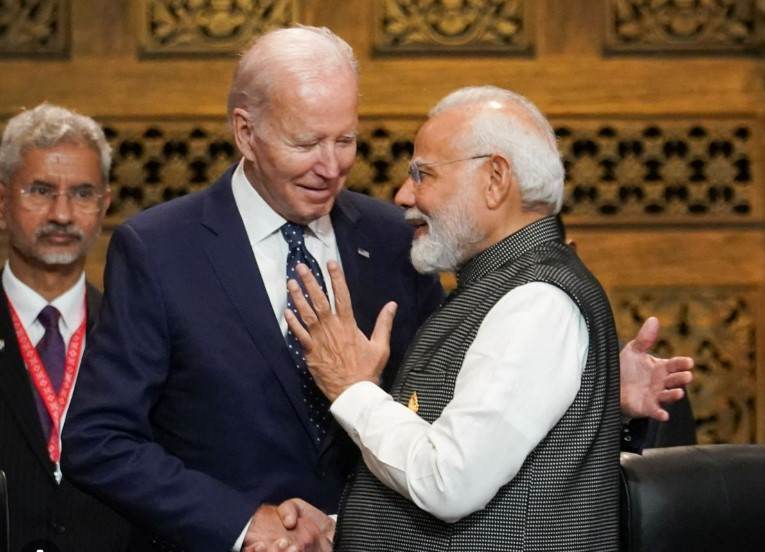Virendra Pandit
New Delhi: It was in the works for some years. And got a boost when India joined the revivified Quadrilateral Security Dialogue (Quad) three years ago, becoming the fourth democracy after the US, Australia, and Japan to create what is viewed as an informal “Asian NATO”, striving to contain China.
Now, as Prime Minister Narendra Modi packs his bags for his much-anticipated State Visit to the United States next month, a US Congressional Select Committee on Chinese Communist Party (CCP) has recommended that India should be made a part of the NATO-Plus group, that currently has five members–Australia, New Zealand, Japan, Israel, and South Korea. It works toward boosting global defense cooperation.
PM Modi will pay his first State Visit to the US from June 21 to 23. He will be hosted at the White House by President Joe Biden, who had, in a lighter vein, recently sought his (PM Modi’s) autograph during an event in Hiroshima, Japan.
The US President will also host PM Modi at a State Dinner on June 22.
By becoming a NATO-Plus member, India will be able to seamlessly share intelligence with the other five countries, the media reported on Saturday.
The House Select Committee on the Strategic Competition between the United States and the CCP, led by Chairman Mike Gallagher and Ranking Member Raja Krishnamoorthi, overwhelmingly adopted a policy proposal to enhance Taiwan’s deterrence, including strengthening NATO Plus to include India.
“Winning the strategic competition with the Chinese Communist Party and ensuring the security of Taiwan demands the United States strengthen ties to our allies and security partners, including India. Including India in NATO Plus security arrangements would build upon the US and India’s close partnership to strengthen global security and deter the aggression of the CCP across the Indo-Pacific region,” the Select Committee recommended.
As per its official website, the Select Committee on the CCP is “committed to working on a bipartisan basis to build consensus on the threat posed by the Chinese Communist Party and develop a plan of action to defend the American people, our economy, and our values.”
The panel’s top Democratic leader Raja Krishnamoorthi of Illinois said that both Democrats and Republicans should work across the aisle.
“We must practice bipartisanship. We must recognize that the CCP wants us to be fractious, partisan, and prejudiced,” said Krishnamoorthi.
Indian-American Ramesh Kapoor, who has been working on this proposal for the past six years, said this is a significant development. He expressed the hope that the recommendation would find a place in the National Defense Authorization Act 2024 and finally end up becoming a law of the land.
The Committee believes that hitting China with economic sanctions in case it plans to attack Taiwan is the most effective way key allies like G-7, NATO, NATO+5, and Quad members join, and negotiate a joint response, and broadcasting this message publicly has the added benefit of enhancing deterrence.
In a statement, the Committee said, “Much like we do joint contingency planning for warfighting, we need to coordinate in peacetime with US allies. To that end, Congress should pass legislation similar to the STAND with Taiwan Act of 2023 that mandates the development of an economic sanctions package to be employed in the event of a PRC attack on Taiwan.”
“The United States should strengthen the NATO Plus arrangement to include India. The United States should also strengthen diplomatic deterrence by supporting Taiwan’s participation in international organizations and amending the TAIPEI Act to provide that the United States, alongside its allies and partners, should publicly oppose any attempts by the CCP to resolve the status of Taiwan’s sovereignty by intentionally misusing, misinterpreting, and misleading others on the underlying purpose of UN Resolution 2758 or the United States’ One China Policy,” it added.
This will be PM Modi’s first State Visit to the US during his nine-year-long reign in India. His predecessor, Dr. Manmohan Singh, had also gone on a State Visit to the US from November 23 to 25, 2009.
While PM Modi has visited the US multiple times during his tenure, none of the visits were categorized as a State Visit, which is the highest-ranked visit according to diplomatic protocol.
His previous visits to the US were classified as a working visit (2014), a working lunch (2016), and an official working visit (2017). His 2019 visit was described by the US Department of State website as the one in which he “Participated in a rally in Houston, Texas.”

